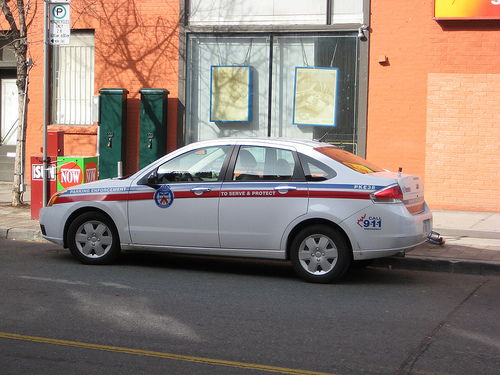Traffic congestion and loathing in Toronto
It may be surprising to some located south of the Canadian border that Toronto has the second worst traffic congestion in Canada, and the sixth most congestion in North America, according to one study. (In case you’re curious, Los Angeles, CA; Honolulu, HI; San Francisco, CA; and Seattle, WA took top “honors.”)
Traffic congestion is more than just an inconvenience in Toronto, it inflicts $3.3 billion CAD in annual costs, according to the study, Costs of Road Congestion in the Greater Toronto and Hamilton Area. Costs distributed among travel delays, environmental impact, a heightened chance of vehicle collisions and raised vehicle costs. It’s expected that the costs will rise to $7.8 billion by the year 2031.

Note the “motorcycles only” sign. Physician, heal thyself! From William Mewes.
Plus, time lost to travel delays results in lowered productivity, which, according to the same study, results in a $2.7 billion hit to the gross domestic product. On a daily basis for the city’s commuters, it’s a time drain: Commutes into downtown Toronto from residential areas such as Newmarket, a smaller city about 31 miles north, can take drivers as long as three hours.
A variety of solutions have been proposed to address the situation on Toronto’s overcrowded roads. CBCNews reported in April about “location efficient mortgages,” which means bringing down costs in those neighborhoods located in walkable, transit-centric areas, so that more people don’t have to rely on cars. Additional suggested solutions include carpooling, private shuttles, and improvements to public transit.
Those public transit improvements have come under especial fire. Toronto’s transit agency, Metrolinx, published a plan, “The Big Move,” in 2008, recommending projects related to train, light rail, and bus rapid transit in the city. But the agency has been criticized for not wielding enough power to push their solutions through, while the plan has been criticized for not incorporating traffic-reduction measures.
The city’s general manager of transportation services, Stephen Buckley, has said, “You don’t solve traffic.” Instead, he’s advocated for short-term improvements, including analyzing intersections, and timing the traffic signals. In fact, the city announced a three-year plan to do just that last week, re-timing traffic signals at 1,000 intersections throughout the city to help relieve congestion in its busier areas.

Toronto is resorting to creative light retiming to cut down on congestion. From roadtrafficsigns.com.
Aiming at congested spots that have five-plus years of data behind them, the project will reprogram specific signals at intersections. It may also include the installation of electronic signs as well as up to 100 cameras, to study traffic and respond to emergencies more quickly. Tests thus far on specific intersections have revealed positive changes, including improvements in greenhouse gas emissions, time delays, fuel usage, speeding and stops. The National Post reported on one such test case: On one intersection that had 16 signals reprogrammed, the amount of total delays decreased by 29%. Additionally, the average speed increased by 10% and vehicle stops decreased by 15%.

Cities facing traffic problems often have to put together a patchwork of congestion solutions. Toronto is trying to do just that – but it has its critics. From Jamie McCaffrey.
Yet the costs are steep: $7.4 million budgeted for this year’s improvements and $10.9 million for next year’s. And the program has its critics, among them Councillor David Shiner, who, calling the program a “band-aid solution,” insisted that a long-term solution to traffic congestion requires halting construction and development until a suitable public transport system can be implemented. It remains to be seen if long-term and short-term solutions will dovetail effectively enough to create a traffic solution in Toronto.
Category: Automotive, Enforcement, Traffic law
















Comments (2)
Sites That Link to this Post